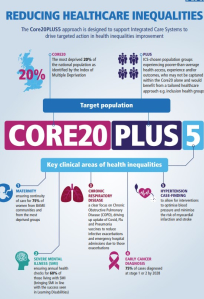New approach provides focus for health inequalities reduction
Planning guidance for the second half of the current year restated that tackling health inequalities was a priority for the whole NHS. But a new Core20plus5 approach seeks to help systems to take this requirement forward in a more targeted way.
The approach is described in an infographic and a discussion paper published this week. The paper supports a survey, the results of which will inform further development.
Using the approach, systems will identify a target population cohort, made up of the most deprived 20% of the population as identified by the national index of multiple deprivation (IMD) – the core20. The ‘plus’ refers to the addition by the system of any other locally determined groups experiencing poorer than average health access, experience or outcomes.
Having defined this target population, systems are then being asked to focus accelerated improvement work on five clinical areas for this population: maternity, severe mental illness (SMI); chronic respiratory disease; early cancer diagnosis; and hypertension case finding. The clinical areas are already subject to NHS long-term plan and other commitments.
For example, in maternity the national aim is to ensure continuity of care for 75% of women from black, Asian and minority ethnic communities and from the most deprived groups. On mental illness, systems are expected to provide annual health checks for 60% of those living with SMI.
For respiratory disease, system should have a ‘clear focus’ on chronic obstructive pulmonary disease, driving up uptake of Covid, flu and pneumonia vaccines to reduce infective exacerbations and emergency admissions. In cancer, the target is for 75% of cases to be diagnosed at stage 1 or 2 by 2028. And on hypertension, systems are asked to ‘allow for interventions to optimise blood pressure and minimise the risk of myocardial infarction and stroke’.
The Core20plus5 work has been developed by NHS England and NHS Improvement’s health inequalities improvement team, led by health inequalities director Bola Owolabi* (pictured). The guidance makes clear that the five clinical focus areas are a priority for the Core20plus5 population. ‘This approach enables the biggest impact on avoidable mortality in these populations and contributes to an overall narrowing of the health inequalities gap,’ it said.
With a recognition that integrated care systems are starting from different places and with different ‘opportunity gaps’, systems are expected to make ‘a proportionate contribution to achieving the national trajectories set out in the five clinical area’. However, all systems are expected to see a measurable improvement in access, experience and outcomes in their defined populations.
Systems are not being asked to discontinue existing priorities and no new governance framework will accompany the approach. A list of high impact actions will be developed to provide systems with a menu of options for engaging their defined communities.
There will also be some funding to support the agenda. According to the guidance, the funding allocation will provide for an 8A role or equivalent in each of the 42 ICSs, ‘on a fair share scheme basis’, as well as two roles at the regional level across the seven regions. A health inequalities improvement dashboard will contain metrics on the five clinical areas as well as other health inequality indicators.
The survey, is aimed at health inequalities professionals, healthcare professionals with an interest in reducing health inequalities and community organisations and is open until 19 November.
*Dr Owolabi is speaking at the HFMA annual conference in December
Related content
We are excited to bring you a fun packed Eastern Branch Conference in 2025 over three days.
This event is for those that will benefit from an overview of costing in the NHS or those new to costing and will cover why we cost and the processes.